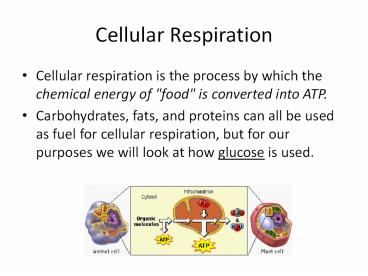Cellular Respiration - PowerPoint PPT Presentation
1 / 22
Title: Cellular Respiration
1
Cellular Respiration
- Cellular respiration is the process by which the
chemical energy of "food" is converted into ATP. - Carbohydrates, fats, and proteins can all be used
as fuel for cellular respiration, but for our
purposes we will look at how glucose is used.
2
Cellular Respiration
- In the presence of oxygen, one gram of glucose
releases 3811 calories of heat energy. - However, if you were to read a nutrition label it
would claim that one gram of glucose only
releases 3.8 Calories. - What is the difference between a calorie and
Calorie? - A food calorie, or Calorie, is actually equal to
1000 calories, or 1 kcal. One calorie is the
energy it takes to heat 1 g of water by 1 C.
Therefore one Calorie, or food calorie, is just
1000 times that, or the energy to heat 1 kg of
water by 1 C.
3
Overview of Respiration
- Respiration, like photosynthesis, is a multi-step
process. - The first step is a process called glycolysis.
4
Glycolysis
- In glycolysis glucose is broken down into two
molecules of pyruvate. - This change is accompanied by a net gain of 2 ATP
molecules and 2 NADH molecules.
5
Glycolysis
- Notice from the picture that glycolysis requires
some energy input.
2 ATP go in and 4 ATP come out for a net gain of
2 ATP.
6
Glycolysis
- Also notice that glycolysis produces a molecule
called NADH. - NAD NADH
- This is very similar to the electron carrier we
saw in photosynthesis. - NADP NADPH
- If you are worried about getting the two confused
just think NADPH has a P and is in
Photosynthesis.
7
Glycolysis
- Glycolysis occurs in ALL organisms.
- Glycolysis occurs in the cytoplasm of cells.
- It is always the FIRST step in converting the
energy in food into ATP. - Lets check it out!
8
Following Glycolysis
Glucose
Glycolysis
2 Pyruvate, 2 ATP 2 NADH
In the presence of Oxygen
In the absence of Oxygen
Fermentation
Kreb Cycle Electron Transport Chain
Anaerobic Respiration
Aerobic Respiration
9
Anaerobic Respiration
- Following glycolysis if oxygen is not present,
pyruvate is metabolized in a process called
fermentation. - Fermentation complements glycolysis by recycling
NADH back into NAD - This allows glycolysis to continue and ATP to be
produced.
10
Fermentation
- Notice the recycling of NAD for glycolysis
11
Fermentation
- There are two types of fermentation
- Lactic Acid Fermentation
- Lactic Acid is formed during fermentation.
- This occurs in our muscles.
- Alcoholic Fermentation
- Alcohol (and CO2) is formed during fermentation.
- This occurs in bacteria.
12
Fermentation
- Fermentation can be performed by all organisms.
- It occurs following glycolysis in the absence of
Oxygen. - Fermentation occurs in the cytoplasm of cells.
13
Summary of Anaerobic Respiration
The purpose of respiration is to convert the
energy in food into ATP. How much ATP does
anaerobic respiration create?
14
Following Glycolysis
Glucose
Glycolysis
2 Pyruvate, 2 ATP 2 NADH
In the presence of Oxygen
In the absence of Oxygen
Fermentation
Kreb Cycle Electron Transport Chain
Anaerobic Respiration
Aerobic Respiration
15
Aerobic Respiration
- Following glycolysis if oxygen is present,
pyruvate is metabolized in two processes called - The Kreb Cycle
- Electron Transport Chain
- The equation for aerobic respiration is
16
From Glycolysis to the Kreb Cycle
- Following glycolysis, pyruvate is transported
into the mitochondria. - As it moves it loses carbon dioxide to form
acetyl-CoA, a 2-carbon molecule. - This process creates NADH.
17
Kreb Cycle
- The Krebs cycle occurs in the mitochondrial
matrix. It turns Acetyl-CoA into CO2. In doing
so it generates a pool of chemical energy (ATP,
NADH, and FADH2). - Click picture to follow the link
18
Electron Transport Chain
Click on the picture to see it in action
19
Electron Transport Chain (ETC)
- The electron transport chain (ETC) consists of a
series of molecules, mostly proteins, embedded in
the inner mitochondrial membrane. - The electron transport chain captures the
electrons stored in NADH and FADH2 and passes
them along the membrane. - As the electrons move along the membrane H build
up in the intermembrane space. - The electrons are eventually passed to Oxygen.
This makes Oxygen very negative. It quickly
bonds with H to form water. - The H that has built up in the intermembrane
space wants out! It flows through a molecule
called ATP synthase. As it does ATP is formed. - Each NADH that donates electrons to the chain
will fuel the creation of 3 ATP. - Each FADH2 that donates elections to the chain
will fuel the creation of 2 ATP.
20
Aerobic Respiration
Glucose Carbon Dioxide During glycolysis, the
formation of Acetyl- CoA the Kreb
Cycle Oxygen Water During the electron
transport chain
21
Aerobic Respiration
- Aerobic Respiration has three distinct parts
- Glycolysis occurs in the cytoplasm (yields 2 ATP)
- Krebs cycle takes place in the matrix of the
mitochondria (yields 2 ATP) - Electron transport chain is carried out on the
inner mitochondrial membrane (yields 34 ATP) - Total ATP 38!!!!
22
SUMMARY
Glycolysis
Anaerobic Respiration
Aerobic Respiration
2 ATP
38 ATP

